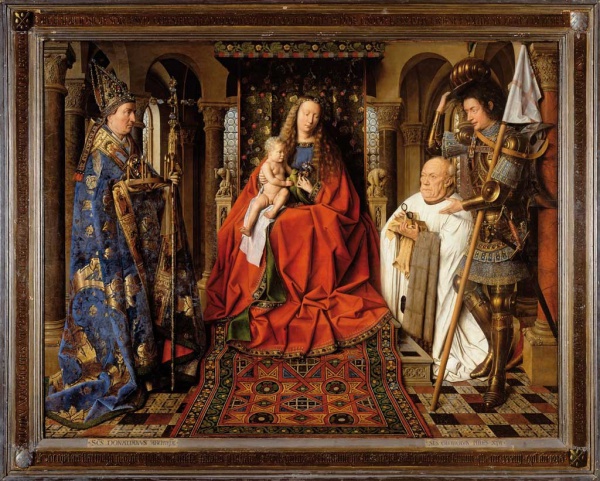Facts About Virgin and Child with Canon van der Paele
"The Virgin and Child with Canon van der Paele" is an extraordinary oil painting by Jan van Eyck, completed around 1434–36. This masterpiece portrays Joris van der Paele, a wealthy clergyman from Bruges, surrounded by saints in a setting reminiscent of a church. Van der Paele commissioned this painting as an altarpiece to serve as his memorial.
The artwork is renowned for its intricate details, especially in the clothing and religious symbols, with Latin inscriptions identifying the saints and the donor. Van Eyck's meticulous craftsmanship is evident throughout the piece.
Van der Paele, prompted by his illness and thoughts of mortality, commissioned this painting while he endowed chaplaincies and sought intercessory prayers through masses. The painting's iconography includes references to Christ's death and resurrection, set in a fictional church inspired by Romanesque architecture. The panel's frame features inscriptions with van Eyck's signature, the completion date, and texts related to the saints depicted.
The figures in the painting—such as the Virgin and Child, St. Donatian, St. George, and Van der Paele himself—are portrayed with realism and profound symbolic significance. Van Eyck's skill with oil paint is evident in the detailed depictions of clothing and architectural elements. The painting's influence was so profound that numerous copies were made in subsequent centuries.
The painting's journey includes a move from the church it was originally painted for to the Musée du Louvre, and eventually, its return to Bruges. Today, it is part of the collection at the Groeningemuseum. The original frame, inscriptions, and the panel's overall condition add to its historical and artistic value.
"The Virgin and Child with Canon van der Paele" is considered a masterpiece of Early Netherlandish art, showcasing van Eyck's technical prowess and innovative approach to religious iconography.

 Luxembourg
Luxembourg